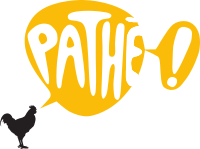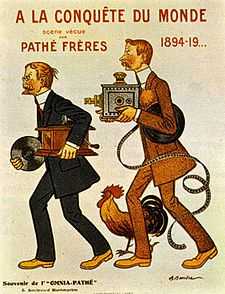Pathé

Pathé or Pathé Frères (French pronunciation: [pate fʁɛʁ], styled as PATHÉ!) is the name of various French businesses founded and originally run by the Pathé Brothers of France from 1896. In the early 1900s, Pathé became the world's largest film equipment and production company, as well as a major producer of phonograph records. In 1908, Pathé had invented the newsreel that was shown in theaters prior to a feature film.
History

by Adrien Barrère




The company was founded as Société Pathé Frères (Pathé Brothers Company) in Paris, France on 28 September 1896, by the four brothers Charles, Émile, Théophile and Jacques Pathé. During the first part of the 20th century, Pathé became the largest film equipment and production company in the world, as well as a major producer of phonograph records.
The driving force behind the film operation was Charles Pathé, who had helped open a gramophone shop in 1894 and then established a phonograph factory at Chatou on the western outskirts of Paris. As these became successful, he saw the opportunities offered by new means of entertainment and in particular by the fledgling motion picture industry. Having decided to expand the record business to include film equipment, Charles Pathé oversaw a rapid expansion of the company. To finance its growth, he took the company public under the name Compagnie Générale des Établissements Pathé Frères Phonographes & Cinématographes (sometimes abbreviated as "C.G.P.C.") in 1897, and its shares were listed on the Paris Stock Exchange.[1]
In 1896, Mitchell Mark of Buffalo, New York, may have been the first American to import Pathé films to the United States, where they were shown in the Vitascope Theater.
In 1902, Pathé acquired the Lumière brothers' patents and then set about to design an improved studio camera and to make their own film stock. Their technologically advanced equipment, new processing facilities built at Vincennes, and aggressive merchandising combined with efficient distribution systems allowed them to capture a huge share of the international market. They first expanded to London in 1902 where they set up production facilities and a chain of movie theaters. By 1909, Pathé had built more than 200 movie theaters in France and Belgium and by the following year they had facilities in Madrid, Moscow, Rome and New York City plus Australia and Japan. Slightly later, they opened a film exchange in Buffalo, New York. Prior to the outbreak of World War I, Pathé dominated Europe's market in motion picture cameras and projectors. It has been estimated[2] that at one time, 60 percent of all films were shot with Pathé equipment. In 1908, Pathé distributed Excursion to the Moon by Segundo de Chomón, an imitation of Georges Méliès's A Trip to the Moon. Pathé and Méliès worked together in 1911. Georges Méliès made a film Baron Munchausen's Dream, his first film to be distributed by Pathé. Pathé's relationship with Méliès soured, and in 1913 Méliès went bankrupt, and his last film was never released by Pathé.
Innovations
Worldwide, the company emphasized research, investing in such experiments as hand-coloured film and the synchronisation of film and gramophone recordings. In 1908, Pathé invented the newsreel that was shown in theaters prior to the feature film. The news clips featured the Pathé logo of a crowing rooster at the beginning of each reel. In 1912, it introduced 28 mm non-flammable film and equipment under the brand name Pathescope. Pathé News produced cinema newsreels from 1910, up until the 1970s when production ceased as a result of mass television ownership.[3] In the United States, beginning in 1914, the company's film production studios in Fort Lee, New Jersey produced the extremely successful serialized episodes called The Perils of Pauline. By 1918 Pathé had grown to the point where it was necessary to separate operations into two distinct divisions. With Emile Pathé as chief executive, Pathé Records dealt exclusively with phonographs and recordings while brother Charles managed Pathé-Cinéma which was responsible for film production, distribution, and exhibition. 1922 saw the introduction of the Pathé Baby home film system using a new 9.5 mm film stock which became popular over the next few decades. In 1921, Pathé sold off its United States motion picture production arm, which was renamed "Pathé Exchange" and later merged into RKO Pictures, disappearing as an independent brand in 1931. Pathé sold its British film studios to Eastman Kodak in 1927 while maintaining the theater and distribution arm.
Natan to Parretti
Pathé was already in substantial financial trouble when Bernard Natan took control of the company in 1929. Studio founder Charles Pathé had been selling assets for several years to boost investor value and keep the studio's cash flow healthy. The company's founder had even sold Pathé's name and "rooster" trademark to other companies in return for a mere 2 percent of revenues. Natan had the bad luck to take charge of the studio just as the Great Depression convulsed the French economy.[4][5][6]
Natan attempted to steady Pathé's finances and implement modern film industry practices at the studio. Natan acquired another film studio, Sociètè des Cinéromans, from Arthur Bernède and Gaston Leroux, which enabled Pathé to expand into projector and electronics manufacturing. He also bought the Fornier chain of motion picture theaters and rapidly expanded the chain's nationwide presence.[4][5][6][7] The French press, however, attacked Natan mercilessly for his stewardship of Pathé. Many of these attacks were antisemitic.[citation needed]
Pathé-Natan did well under Natan's guidance. Between 1930 and 1935, despite the world economic crisis, the company made 100 million francs in profits, and produced and released more than 60 feature films (just as many films as major American studios produced at the time). He resumed production of the newsreel Pathé News, which had not been produced since 1927.[4]
Natan also invested heavily into research and development to expand Pathe's film business. In 1929, he pushed Pathé into sound film. In September, the studio produced its first sound feature film, and its first sound newsreel a month later. Natan also launched two new cinema-related magazines, Pathé-Revue and Actualités Féminines, to help market Pathé's films and build consumer demand for cinema. Under Natan, Pathé also funded the research of Henri Chrétien, who developed the anamorphic lens (leading to the creation of CinemaScope and other widescreen film formats common today).[4][5][6][7]
Natan expanded Pathé's business interests into communications industries other than film. In November 1929, Natan established France's first television company, Télévision-Baird-Natan. A year later, he purchased a radio station in Paris and formed a holding company (Radio-Natan-Vitus) to run what would become a burgeoning radio empire.[4][5][6][7]
But in 1935, Pathé went bankrupt. In order to finance the company's continued expansion, Pathé's board of directors (which still included Charles Pathé) voted in 1930 to issue shares worth 105 million francs. But with the depression deepening, only 50 percent of the shares were purchased. One of the investor banks collapsed due to financial difficulties unrelated to Pathé's problems, and Pathé was forced to follow through with the purchase of several movie theater chains it no longer could afford to buy. Although the company continued to make a profit (as noted above), it lost more money than it could bring in.[4][5][6][7]
The collapse of Pathé led French authorities to indict Bernard Natan on charges of fraud. Natan was accused of financing the purchase of the company without any collateral, of bilking investors by establishing fictitious shell corporations, and negligent financial mismanagement. Natan was even accused of hiding his Romanian and Jewish heritage by changing his name. Natan was indicted and imprisoned in 1939. A second indictment was brought in 1941, and he was convicted shortly thereafter. He was freed in September 1942.[4][5][6][7]
The company was forced to undergo a restructuring in 1943 and was acquired by Adrien Ramauge.[citation needed] Over the years, the business underwent a number of changes including diversification into producing programs for the burgeoning television industry. During the 1970s, operating theaters overtook film production as Pathé's primary source of revenue. In the late 1980s, Italian financier Giancarlo Parretti tried to make a bid for Pathé, even taking over a smaller distributor and renaming it Pathé Communications in anticipation of owning the storied studio. Parretti's shady past, however, raised enough eyebrows in the French government that the deal fell through. It turned out to be a fortunate decision, as Parretti later took over Metro-Goldwyn-Mayer, only to lose it in a bankruptcy.
Jérôme Seydoux
In 1990 Chargeurs, a French conglomerate led by Jérôme Seydoux, took control of the company.[8] As a result of the deregulation of the French telecommunications market, in June 1999 Pathé merged with Vivendi, the exchange ratio for the merger fixed at three Vivendi shares for every two Pathé shares. The Wall Street Journal estimated the value of the deal at US$2.59 billion. Following the completion of the merger, Vivendi retained Pathé's interests in British Sky Broadcasting and CanalSatellite, a French broadcasting corporation, but then sold all remaining assets to Jérôme Seydoux's family-owned corporation, "Fornier SA," who changed its name to Pathé.
Sectors

The sectors in which Pathé operates today are:
- Cinema:
- production
- distribution to theatres and homes
- the international management of a catalog of more than 500 films
- movie theaters
- EuroPalaces (network which federates the Pathé theatres and Gaumont) ; see also movie theaters in the Netherlands
- Cable and satellite television networks:
- TMC (Télé Monte Carlo)
- Comédie! (majority shareholder)
- cuisine.tv
- Voyage
- The Conseil Supérieur de l'Audiovisuel retained 3 of the projects of the group for digital terrestrial television: TMC, Comédie! and cuisine.tv.
International distribution
Outside of France, Pathé does release their film library on VHS or DVD. Other distributors like 20th Century Fox Home Entertainment in the UK distributed Pathé films for VHS/DVD release.
In the UK, 20th Century Fox (1998–2010, 2011–present) and Warner Bros. (2010) releases upcoming films by Pathé theatrically.
Films
Films distributed by Pathé include:
|
|
See also
- Category:Pathé films
- Pathé Records
- Pathé News and British Pathé
- List of film serials by studio lists the Pathé film serials
- Fumagalli, Pion & C., Italian Pathé importer
References
Notes
- ↑ Charles Morand Pathé: French producer, manufacturer, Henri Bousquet, Who's Who of Victorian Cinema
- ↑ "Film and Electrolux through the ages". Electrolux. Retrieved 2013-01-13.
- ↑ Researcher's Guide to British Newsreels 3. British Universities Film & Video Council. 1993. p. 80. ISBN 0-901299-65-0.
- ↑ 4.0 4.1 4.2 4.3 4.4 4.5 4.6 Willems, Gilles "Les origines de Pathé-Natan" In Une Histoire Économique du Cinéma Français (1895–1995), Regards Croisés Franco-Américains, Pierre-Jean Benghozi and Christian Delage, eds. Paris: Harmattan, Collection Champs Visuels, 1997. English translation: The origins of Pathé-Natan La Trobe University
- ↑ 5.0 5.1 5.2 5.3 5.4 5.5 Abel, Richard. The Red Rooster Scare: Making Cinema American, 1900–1910 Berkeley: University of California Press, 1999, ISBN 0-520-21478-1
- ↑ 6.0 6.1 6.2 6.3 6.4 6.5 Abel, Richard. French Cinema: The First Wave 1915–1929 Paperback ed. Princeton: Princeton University Press, 1987, ISBN 0-691-00813-2
- ↑ 7.0 7.1 7.2 7.3 7.4 Willems, Gilles "Les Origines du Groupe Pathé-Natan et le Modele Americain" Vingtième Siècle 46 (April–June 1995)
- ↑ "Pathé, Gaumont and Seydoux: Pathe". Ketupa.net. Retrieved 2010-10-19.
External links
- Pathé SA
- British Pathé
- One of the first films Pathé "Moscow clad in snow", 00:07:22, 1908 on YouTube
- SMU's Sulphur Springs Collection of Pre-Nickelodeon Films contains nine Pre-Nickelodeon movies, including one Pathé Frères film, "Le Laveur de devantures, (Pathé's English title: The window cleaner)"